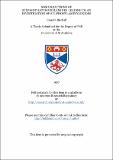Files in this item
Some reactions of sulphonylhydroxylamines leading to an investigation of sulphonylaminyloxides
Item metadata
| dc.contributor.advisor | Glidewell, Christopher | |
| dc.contributor.author | Birchall, John D. | |
| dc.coverage.spatial | ix,190 p. | en_US |
| dc.date.accessioned | 2018-07-02T13:44:03Z | |
| dc.date.available | 2018-07-02T13:44:03Z | |
| dc.date.issued | 1977 | |
| dc.identifier.uri | https://hdl.handle.net/10023/14808 | |
| dc.description.abstract | Mercury (II) and lead (II) ions, but not mercury (l) and thallium (I), react with both the nitrosyIdisulphonate, ON(S0₃)₂₂- and the hydroxylaminedisulphonate dianions, ON(S0₃)₂²⁻-, to yield the corresponding metal sulphate and a mixture of sulphate and sulphite ions. Silver (I) ions are reduced to the metal by both anions, but reacts with potassium imidodisulphonate, HN(SO₃K)₂, and tripotassium imidodisulphonate, KN(S0₃K)₂, to yield trisilver imidodisulphonate, Ag₃NS₂O₆, and disilver potassium imidodisulphonate, Ag₂KNS₂O₆. The reaction of some related salts are also reported. Mechanisms for some of the decompositions, and stoichiometric equations are proposed. No metal salts of hydroxylaminedisulphonates, HON(SO₃M)₂ were isolated. The silver imidodisulphonate salts failed to react with both alkyl and aryl halides. A series of N, N-bis-(arylsulphonyl)hydroxylamines, (p-XC₆H₄S₂)₂N0, were synthesised (X = H, Me, MeO, Cl and F). The species (p-XC₆H₄S₂)₂N0, p-XC₆H₄S₂NO and p-XC₆H₄S₂ are proposed as intermediates during the oxidation of the bis-species with PbO₂, silver (I,III) oxide, AgO, MnO₂. Pb(O₂CMe)₄ or nitric acid to N, N, 0-tris-(arylsulphonyl)hydroxylamines, p-XC₆H₄S₂)₂N0S₂C₆H₄X-p and nitrate ion. A mechanism involving hydroxylamine is ruled out. I. r. and n.m.r. spectra show that the tris-species are hydroxylamines, R₂NOR, rather than amine oxides, R₃NO, and the structure is considered by a comparison with (CF208)₂NOH and (CF₃)₂NO. The e.s.r. spectra of the tris-species in benzene indicates the presence of a nitroxide radical. The bis-species are found to decompose to the tris-hydroxylamine and the corresponding arenesulphonic acid, while the tris-species decompose to the sulphonic acid. Oligomerisation of cyclohexene is observed during the oxidation of bis-hydroxylamines, while with bases, such as pyridine, the hydroxylamine is converted to a mixture of (RSO₂)₂NH pyridine-N-oxide and a pyridinium arylsulphonate. N, N, 0-tris-(Alkyl-sulphonyl) hydroxylamines could not be isolated. Nitrosylarene-sulphinates, p-XC₆H₄SO₂NO are proposed as intermediates but could not be isolated from the reactions of nitrosyl chloride and nitrogen (II) oxide with arylsulphonylhydroxylamines. p-XC₆H₄SO₂NHOH, (p-XC₆H₄SO₂)₂NOH and p-XC₆H₄SO₂NH₂ (X=H, CH₃) are all are converted by NOCl to p-XC₆H₄SO₂Cl, but (p-XC₆H₄S0₂)₂N0S0₂C₆H₄X-p and (p-XC₆H₄SO₂)₂NH are unaffected. Oxidation of C₆H₅SO₂NHOH by a range of oxidants yielded, C₆H₅SO₂Cl, C₆H₅SO₃H, or (C₆H₅SO₂)₂NOSO₂C₆H₅, but not C₆H₅SO₂NO. Diene cycloaddition products of p-XC₆H₄SO₂NO could not be isolated. p-CH₃C₆H₄SO₂Na is converted by nitrosyl chloride to p-CH₃C₆H₄SO₂Cl rather than to p-CH₃C₆H₄SO₂NO. (p-CH₃C₆H₄SO₂)₂NH is inert to a wide range of oxidants. Both (p-XC₆H₄S0₂)₂NOH and (p-XC₆H₄S0₂)₂N0S0₂C₆H₄X-p initiate free-radical halogenation by dichlorine and dibromine, but not by diiodine, of benzene and cyclohexane. Simple carboxyamides also initiate free-radical chlorination of the same substrates. (N-aryl-N-arylsulphonyl) hydroxylamines were oxidised by PbO₂ and Pb(0₂CMe)₄, but not MnO₂, to a mixture of the corresponding [N- aryl-N, O -bis(aryl sulphonyl)]hydroxylamine, nitrobenzene and azoxybenzene. The tris-species appears to contain the nitroxide radical, ArS0₂N(0)Ar¹. A similar mechanism to that for the oxidation of (p-XC₆H₄S0₂)₂N0H is proposed. | en_US |
| dc.language.iso | en | en_US |
| dc.publisher | University of St Andrews | |
| dc.subject.lcc | QD281.H85B5 | |
| dc.subject.lcsh | Hydroxylation | en |
| dc.title | Some reactions of sulphonylhydroxylamines leading to an investigation of sulphonylaminyloxides | en_US |
| dc.type | Thesis | en_US |
| dc.type.qualificationlevel | Doctoral | en_US |
| dc.type.qualificationname | PhD Doctor of Philosophy | en_US |
| dc.publisher.institution | The University of St Andrews | en_US |
| dc.publisher.department | Department of Chemistry, University of St Andrews | en_US |
This item appears in the following Collection(s)
Items in the St Andrews Research Repository are protected by copyright, with all rights reserved, unless otherwise indicated.

